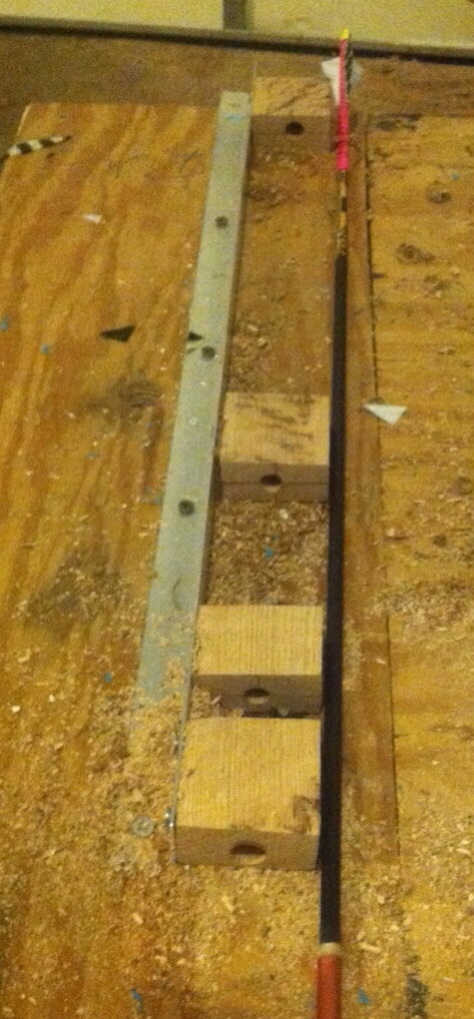Home › Forums › Friends of FOC › Birch plywood arrow shafts
-
AuthorPosts
-
-
Hello everyone! I’m new here, and I have searched the whole web looking for any info on diy plywood dowels (shafts). I built a doweling jig that works great, but I want to shoot the heaviest shaft possible and be able to get a high FOC percentage. I have two questions:
1. If I can buy a sheet of premium birch plywood and mill it cleanly into shafts, can I taper them lengthwise without sacrificing integrity? (glue line runout)
or
2. Would I be wasting my time in trying plywood and instead should I just find some nice quarter sawn ash?
I live in East Tennessee and fortunately have access to several lumber yards with great selections. I know it’d be simpler to buy shafts pre cut, but I’m a fairly hands on kind of guy and I like to “tinker” as my wife so lovingly puts it.
Thanks for your reply, and it’s great to be here!
Note* I went a looked at Lowes for birch plywood, and the laminations are too few and far between to be useful.
-
cpbiv,
Welcome! You pose an interesting question. I think quarter sawn lumber will be your best bet, as finding a birch ply product with thin enough laminations and no voids will be an issue.
I am sure there are specialty wood dealers out there, but the cost would be prohibitive.
Keep us up to date on your arrow build.
-
I’d like to see pictures of your dowling jig!
On your questions about shafts… You can’t have both a heavy shaft, and high FOC. You must pick one.
If you go with wood arrows, you will have a heavy shaft. That’s good. If you go with carbon, you can have a light shaft and heavy point resulting in a high FOC arrow and a heavy shaft.
But it sounds like you are committed to wood. That’s great. I’ve used laminated beach shafts from Allegheny Mountain Archery. They were crazy heavy though. Like 900 grains.
As for tapering the laminated shafts, should be no problem.
-
Thanks for the welcome and reply!
I’m pretty set on using wood shafts; as anything I can produce myself increases the satisfaction for me. I hunted with carbon shafts the past few years with a high FOC(somewhere around 20-22%, I can’t remember exactly) but the structural integrity of those shafts was lees than stellar on the last whitetail I took. (Broke behind the head on the far front shoulder. Heart and lung shot, quick recovery)
I guess I’ll go with ash shafts and try to get around a 300 gr. head for a good FOC. A problem I face with heavy heads is that my arrows have to be at least 31″ long because I have a 29-30″ draw.(freakishly long arms). So, I end up with a heavily spined and large diameter shaft. If there’s another readily available hardwood that would be better suited to my needs than ash, please let me know.
I’ll get a pic of my jig when I make it back home. I got the plans from a back issue of TBM, early 90’s I think.
-
Kevin Forrester at http://www.forresterwoodshafts.com/ has an awesome range of hardwoods. His leopardwood goes up to 95# in 11/32. That’d be a great hardwood option I reckon.
Dave Petersen has experimented a fair bit with Sitka Spruce and a 300 grain head as well, although I think he found it less reliable than a well made carbon shaft. If you searched the forum you might find some of his posts on it, or you could send him a personal message.
You’ve come to the right place my friend, good luck 😀
-
Here is my jig. That’s one of my carbons beside it on the table.

-
Another big welcome aboard. Sorry can’t offer any informed advice on wood (used them in the 60’s and glass) but now after being reintroduced to this trad bow addiction by Dave Petersen I just use carbons. Again welcome and enjoy the dialog.:D
Semper Fi
Mike
-
Thanks again! I appreciate all the help so far! The nostalgia and self-reliance factor of crafting my own wood arrows is what attracts me to it, and building a better mousetrap by getting a high FOC from wood shafts would tickle me to death. BUT, if carbons are the most responsive to high FOC percentages, and that equates to less failure and in turn more ethical kills on big game, then I’ll save the woodies for geese and squirrels. But I’ll still keep working on that mousetrap. Must be my nature I guess.:D
-
I don’t see a cutting tool. Must be using a router that comes up from under the table? Or is it using one of the cutters like Lee Valley sells?
-
Yes, the router is mounted to the bottom of the table. I’m using a 3/8″ straight fluted bit. Then a hi-speed corded electric drill to turn the wood stock through the jig. It leaves a nice, clean dowel when it’s done. The first block is 1/2″ hole and the rest are 3/8″.
-
-
AuthorPosts
- You must be logged in to reply to this topic.

